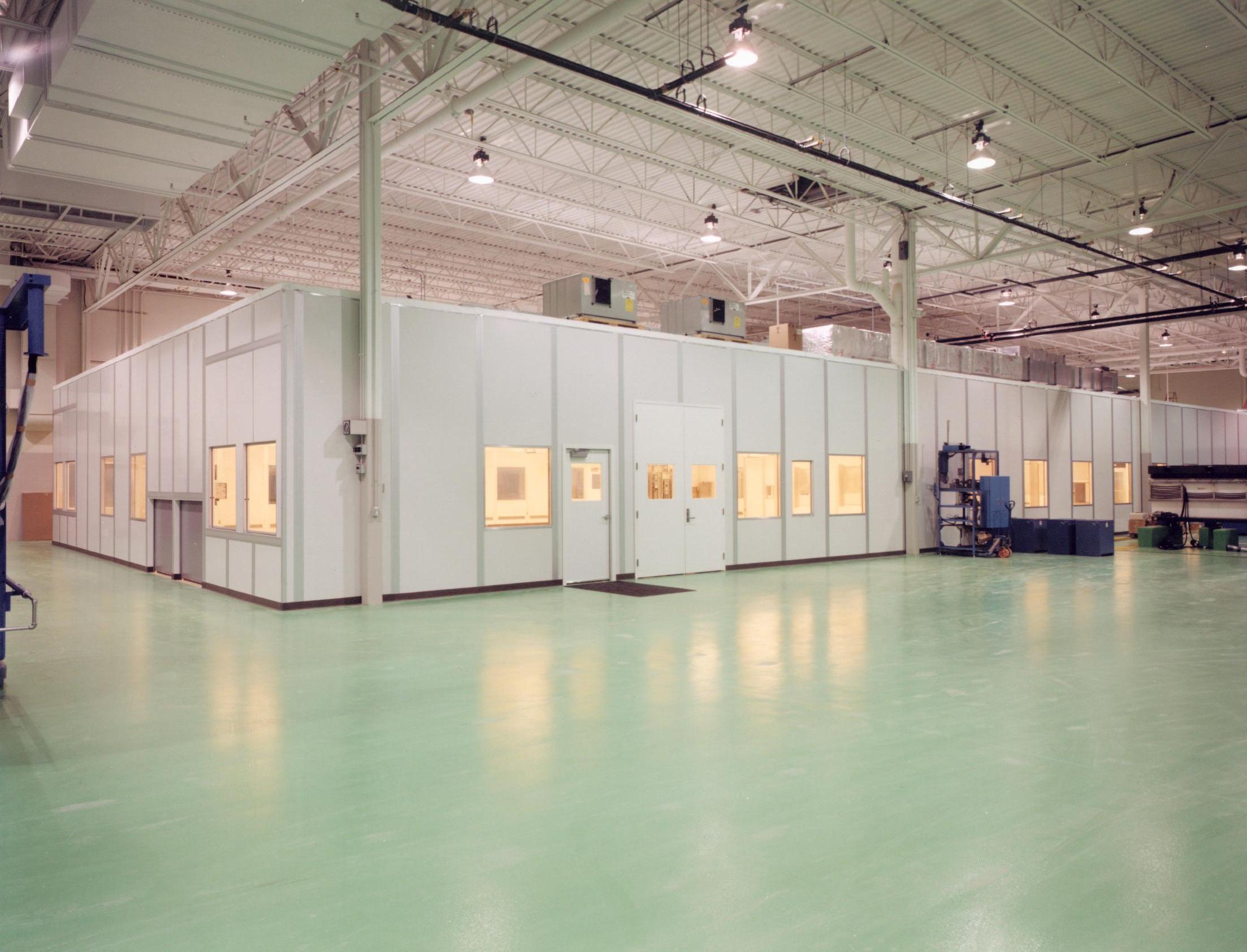Li-ion Battery Manufacturing Cleanrooms
Lithium-ion battery manufacturing requires precisely controlled environments where contamination can compromise product performance and safety. With electric vehicles and energy storage systems driving unprecedented demand for high-quality batteries, manufacturers need cleanrooms that ensure consistent production while controlling costs. Precision Environments has designed and built specialized battery manufacturing cleanrooms since 1989, delivering turnkey solutions from EV battery cleanroom facilities to pharmaceutical applications across diverse industries.

Ready when you are.
Cleanroom Classifications for Battery Production
ISO Class Requirements
Different manufacturing processes within li-ion battery production require specific ISO classifications based on their sensitivity to contamination:
ISO Class 6
(Class 1,000):
Required for electrode coating and active material handling where particle contamination directly impacts battery performance and safety
ISO Class 7
(Class 10,000):
Appropriate for cell manufacturing operations, separator handling, and electrolyte filling processes
ISO Class 8
(Class 100,000):
Suitable for packaging operations, quality control testing, and final assembly processes
Controlled but unclassified environments:

Used for raw material storage, equipment maintenance areas, and administrative spaces within the facility
Air Change Rates and Filtration Standards
Li-ion battery cleanrooms, especially those involved in EV battery manufacturing, typically require 60 to 240 air changes per hour to ensure rapid particle removal and maintain uniform environmental conditions. HEPA filtration systems form the backbone of battery cleanroom air handling, removing 99.97% of particles 0.3 microns and larger, while ULPA filters may be specified for critical applications to achieve 99.999% efficiency at 0.12 microns. Specialized carbon filtration and exhaust systems handle chemical vapors from solvents and electrolytes while maintaining required particle control levels.

Critical Control Parameters in Battery Cleanrooms
- Temperature and Humidity Management
- Electrostatic Discharge (ESD) Protection
- Cross-Contamination Prevention
Temperature stability within ±1°C is essential for consistent electrode coating thickness and electrolyte viscosity control, as fluctuations can cause variations in active material deposition and performance inconsistencies across battery cells.
Humidity control presents one of the most challenging aspects of battery cleanroom design, with lithium salts and electrode materials readily absorbing moisture from the atmosphere. Most battery manufacturing processes require relative humidity levels below 1%, with some critical operations demanding dewpoints as low as -40°C.
Precision Environments designs specialized dehumidification systems integrated with primary air handling equipment to maintain these extreme conditions while minimizing energy consumption and operational costs.
Electrostatic discharge poses significant risks in battery manufacturing, potentially damaging sensitive electronic components or creating ignition sources near flammable solvents. Comprehensive ESD protection includes conductive flooring systems, personnel grounding equipment (such as wrist straps and conductive footwear), and ionization systems that neutralize static charges on materials and equipment surfaces. This protection is particularly important where plastic films and separator materials generate static electricity.
Cleanroom Equipment and Monitoring Systems
Real-Time Particle Monitoring
Continuous particle monitoring systems track cleanroom performance throughout production operations, providing immediate alerts when conditions exceed specification limits. These systems monitor multiple particle sizes simultaneously, with particular focus on particles larger than 0.5 microns that pose the greatest risk to battery quality. Advanced monitoring systems integrate with facility management software to provide trending data, predictive maintenance alerts, and automated reporting capabilities that enable proactive maintenance scheduling.
Environmental Parameter Sensors
Comprehensive environmental monitoring encompasses temperature, humidity, pressure differentials, air velocity, and chemical vapor concentrations through modern sensor networks that provide continuous data logging with alarm capabilities. Precision Environments develops custom monitoring solutions that integrate seamlessly with existing manufacturing execution systems, providing operators with real-time visibility into all critical environmental parameters. Our systems feature redundant sensors for critical measurements and automated calibration capabilities to ensure long-term accuracy.
Quality Control and Certification
Regulatory Compliance Standards
Battery manufacturing cleanrooms must comply with regulatory frameworks. Automotive industry applications require ISO/TS 16949 quality management standards, while energy storage applications may require UL listing and IEEE standards compliance. International shipping requirements add complexity through UN transportation regulations governing lithium battery documentation and packaging.
Precision Environments’ regulatory and compliance consulting services ensure your cleanroom design meets all applicable requirements from project inception through final certification, with subject matter experts who understand the intersection of cleanroom standards and automotive quality management systems.
Testing and Validation Procedures
Comprehensive testing and validation programs ensure cleanroom performance meets specification requirements:
Installation Qualification (IQ)
Documentation of installed equipment and systems meeting design specifications

Operational Qualification (OQ)
Testing of all systems under operational conditions to verify performance parameters

Performance Qualification (PQ):
Extended testing under actual manufacturing conditions to demonstrate sustained performance

Ongoing Certification:
Regular recertification testing to verify continued compliance with cleanliness and environmental specifications

Our comprehensive cleanroom certification process begins with systematic start-up and commissioning, utilizing proprietary standard operating procedures and detailed inspection reports. All testing is performed in compliance with Current Good Manufacturing Practices (cGMP), Institute of Environmental Sciences Technologies (IEST), and International Organization for Standardization (ISO), with third-party certification conducted according to ISO14644-1 and IEST-RP-CC006-2 standards.
FAQ
What ISO class cleanroom is required for li-ion battery manufacturing?
Li-ion battery manufacturing typically requires ISO Class 6 (Class 1,000) for electrode coating and active material handling, ISO Class 7 (Class 10,000) for cell assembly operations, and ISO Class 8 (Class 100,000) for packaging processes. The specific classification depends on the manufacturing step and contamination sensitivity of the particular process.
How do humidity requirements differ in lithium-ion battery cleanrooms compared to other applications?
Lithium-ion battery cleanrooms require extremely low humidity levels, often below 1% relative humidity or dewpoints as low as -40°C, due to the hygroscopic nature of lithium salts and electrode materials. This is significantly more stringent than typical pharmaceutical or semiconductor cleanrooms, requiring specialized dehumidification systems.